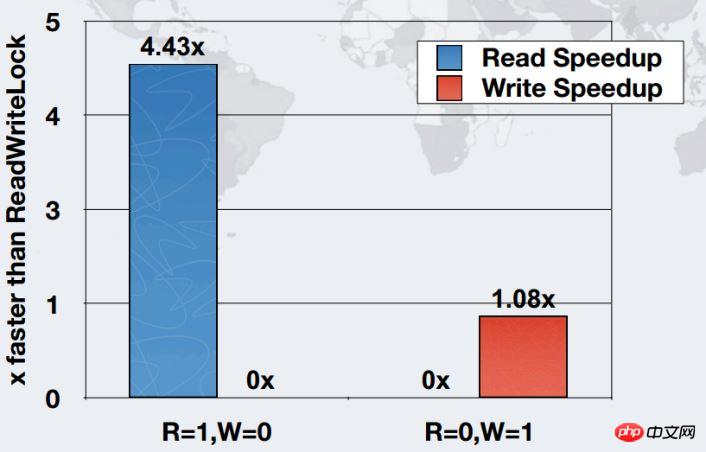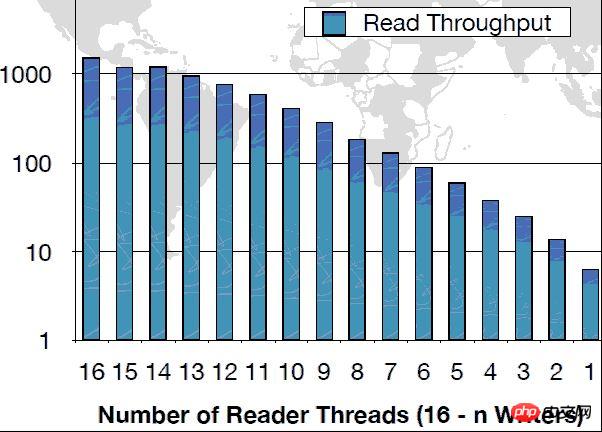Interpretation of new features of Java8--StampedLock
This article conducts a comparative analysis from synchronized, Lock to the new StampedLock in Java8. Friends who are interested in the new features of Java8, StampedLock, should take a look.
Java8 is like a treasure, a small API Improvements are enough to write an article. For example, synchronization has always been an old topic in multi-threaded concurrent programming. I believe no one likes synchronized code. This will reduce the throughput and other performance indicators of the application. In the end, When it is bad, it will hang and crash, but even then you have no choice because you have to ensure the accuracy of the information. Therefore, this article decided to conduct a comparative analysis from synchronized, Lock to the new StampedLock in Java 8. I believe that StampedLock will not disappoint everyone.
synchronizedBefore java5, synchronization was mainly achieved using synchronized. It is a keyword in the Java language. When it is used to modify a method or a code block, it can ensure that at most one thread executes the code at the same time.
There are four different synchronized blocks:1. Instance method
2. Static method
3. Instance method Synchronized block in
4. Synchronized block in static method
Everyone should be familiar with this, so I won’t go into more details. The following is a code example
synchronized(this) // do operation }
Summary: Synchronized has always been a veteran role in multi-threaded concurrent programming. Many people will call it a heavyweight lock. However, with various optimizations of Synchronized in Java SE1.6, the performance has improved. Also improved.
LockIt is added by Java 5 in java.util.con
current.locks an API. Lock is an interface. The core methods are lock(), unlock(), and tryLock(). The implementation classes include ReentrantLock, ReentrantReadWriteLock.ReadLock, ReentrantReadWriteLock.WriteLock;
ReentrantReadWriteLock, ReentrantLock and synchronized locks have the same memory semantics.
Different from synchronized, Lock is entirely written in Java and has nothing to do with JVM implementation at the Java level. Lock provides a more flexible locking mechanism, and many features that synchronized does not provide, such as lock voting, timed lock waiting and interrupt lock waiting, but because lock is implemented through code, to ensure that the lock will be released, you must unLock( ) into finally{}
The following is a code example of Lock
rwlock.writeLock().lock();
try {
// do operation
} finally {
rwlock.writeLock().unlock();
}Summary: A more flexible and scalable lock than synchronized mechanism, but anyway synchronized code is easier to write
StampedLockIt is java8 in java.util.concurrent.locks A new API has been added.
ReentrantReadWriteLock can only obtain the write lock when there is no read-write lock. This can be used to implement pessimistic reading (Pessimistic Reading), that is, if reading is performed during execution, there may often be Another implementation needs to write, in order to maintain synchronization, the read lock of ReentrantReadWriteLock can come in handy.
However, if there are many reads and few writes, using ReentrantReadWriteLock may cause the writing thread to encounter a starvation problem, that is, the writing thread cannot compete. Waiting until locked.
StampedLock control lock has three modes (write, read, optimistic read). A StampedLock state is composed of two parts: version and mode. The lock acquisition method returns a number as the ticket stamp, which uses the corresponding lock state Indicates and controls access, and the number 0 indicates that no write lock is authorized for access. Read locks are divided into pessimistic locks and optimistic locks.
The so-called optimistic read mode, that is, if there are many read operations and few write operations, you can be optimistic that the probability of writing and reading happening at the same time is very small, so Using a full read lock without pessimism, the program can check whether the data has been changed by writing after reading the data, and then take subsequent measures (reread the change information, or
) , this small improvement can greatly improve the throughput of the program! ! The following is an example of StampedLock provided by java doc
class Point {
private double x, y;
private final StampedLock sl = new StampedLock();
void move(double deltaX, double deltaY) { // an exclusively locked method
long stamp = sl.writeLock();
try {
x += deltaX;
y += deltaY;
} finally {
sl.unlockWrite(stamp);
}
}
//下面看看乐观读锁案例
double distanceFromOrigin() { // A read-only method
long stamp = sl.tryOptimisticRead(); //获得一个乐观读锁
double currentX = x, currentY = y; //将两个字段读入本地局部变量
if (!sl.validate(stamp)) { //检查发出乐观读锁后同时是否有其他写锁发生?
stamp = sl.readLock(); //如果没有,我们再次获得一个读悲观锁
try {
currentX = x; // 将两个字段读入本地局部变量
currentY = y; // 将两个字段读入本地局部变量
} finally {
sl.unlockRead(stamp);
}
}
return Math.sqrt(currentX * currentX + currentY * currentY);
}
//下面是悲观读锁案例
void moveIfAtOrigin(double newX, double newY) { // upgrade
// Could instead start with optimistic, not read mode
long stamp = sl.readLock();
try {
while (x == 0.0 && y == 0.0) { //循环,检查当前状态是否符合
long ws = sl.tryConvertToWriteLock(stamp); //将读锁转为写锁
if (ws != 0L) { //这是确认转为写锁是否成功
stamp = ws; //如果成功 替换票据
x = newX; //进行状态改变
y = newY; //进行状态改变
break;
}
else { //如果不能成功转换为写锁
sl.unlockRead(stamp); //我们显式释放读锁
stamp = sl.writeLock(); //显式直接进行写锁 然后再通过循环再试
}
}
} finally {
sl.unlock(stamp); //释放读锁或写锁
}
}
}Summary: StampedLock is cheaper than ReentrantReadWriteLock, which means the consumption is relatively small.
Performance comparison between StampedLock and ReadWriteLockThe following figure shows that compared with ReadWritLock, in the case of one thread, the reading speed is about 4 times that of , writing is 1x.
 The figure below shows that with six threads, the read performance is dozens of times higher, and the write performance is also nearly 10 times:
The figure below shows that with six threads, the read performance is dozens of times higher, and the write performance is also nearly 10 times:
 The following figure shows the throughput improvement:
The following figure shows the throughput improvement:

Summary
1. Synchronized is implemented at the JVM level. Not only can synchronized be monitored through some monitoring tools lock, and if an exception occurs during code execution, the JVM will automatically release the lock;
2, ReentrantLock, ReentrantReadWriteLock, and StampedLock are all locks at the object level. It is necessary to ensure that the lock will be To release, you must put unLock() in finally{};
3. StampedLock has a huge improvement in throughput, especially in scenarios where there are more and more reading threads;
4. StampedLock has a complex API. For locking operations, it is easy to misuse other methods;
5. When there are only a few competitors, synchronized is a good general lock implementation;
6. When thread growth can be estimated, ReentrantLock is a good general-purpose lock implementation;
The above is the detailed content of Interpretation of new features of Java8--StampedLock. For more information, please follow other related articles on the PHP Chinese website!

Hot AI Tools

Undresser.AI Undress
AI-powered app for creating realistic nude photos

AI Clothes Remover
Online AI tool for removing clothes from photos.

Undress AI Tool
Undress images for free

Clothoff.io
AI clothes remover

Video Face Swap
Swap faces in any video effortlessly with our completely free AI face swap tool!

Hot Article

Hot Tools

Notepad++7.3.1
Easy-to-use and free code editor

SublimeText3 Chinese version
Chinese version, very easy to use

Zend Studio 13.0.1
Powerful PHP integrated development environment

Dreamweaver CS6
Visual web development tools

SublimeText3 Mac version
God-level code editing software (SublimeText3)

Hot Topics
 How to display file suffix under Win11 system? Detailed interpretation
Mar 09, 2024 am 08:24 AM
How to display file suffix under Win11 system? Detailed interpretation
Mar 09, 2024 am 08:24 AM
How to display file suffix under Win11 system? Detailed explanation: In the Windows 11 operating system, the file suffix refers to the dot after the file name and the characters after it, which is used to indicate the type of file. By default, the Windows 11 system hides the suffix of the file, so that you can only see the name of the file in the file explorer but cannot intuitively understand the file type. However, for some users, displaying file suffixes is necessary because it helps them better identify file types and perform related operations.
 Introduction to the differences between win7 home version and win7 ultimate version
Jul 12, 2023 pm 08:41 PM
Introduction to the differences between win7 home version and win7 ultimate version
Jul 12, 2023 pm 08:41 PM
Everyone knows that there are many versions of win7 system, such as win7 ultimate version, win7 professional version, win7 home version, etc. Many users are entangled between the home version and the ultimate version, and don’t know which version to choose, so today I will Let me tell you about the differences between Win7 Family Meal and Win7 Ultimate. Let’s take a look. 1. Experience Different Home Basic Edition makes your daily operations faster and simpler, and allows you to access your most frequently used programs and documents faster and more conveniently. Home Premium gives you the best entertainment experience, making it easy to enjoy and share your favorite TV shows, photos, videos, and music. The Ultimate Edition integrates all the functions of each edition and has all the entertainment functions and professional features of Windows 7 Home Premium.
 In which folder is the cookie data on your computer located? Detailed interpretation
Jan 19, 2024 am 10:19 AM
In which folder is the cookie data on your computer located? Detailed interpretation
Jan 19, 2024 am 10:19 AM
With the continuous development of the Internet, people are increasingly inseparable from browsers. In browsers, everyone will use cookies more or less. However, many people don’t know which folder the cookie data is in. Let’s explain it in detail today. First, we need to understand what cookies are. Simply put, a cookie is a piece of text information stored by the browser, which is used to save some of the user's personal settings in the browser or record the user's historical operations, etc. When the user opens the same website again, c
 Master the key concepts of Spring MVC: Understand these important features
Dec 29, 2023 am 09:14 AM
Master the key concepts of Spring MVC: Understand these important features
Dec 29, 2023 am 09:14 AM
Understand the key features of SpringMVC: To master these important concepts, specific code examples are required. SpringMVC is a Java-based web application development framework that helps developers build flexible and scalable structures through the Model-View-Controller (MVC) architectural pattern. web application. Understanding and mastering the key features of SpringMVC will enable us to develop and manage our web applications more efficiently. This article will introduce some important concepts of SpringMVC
 Are there any class-like object-oriented features in Golang?
Mar 19, 2024 pm 02:51 PM
Are there any class-like object-oriented features in Golang?
Mar 19, 2024 pm 02:51 PM
There is no concept of a class in the traditional sense in Golang (Go language), but it provides a data type called a structure, through which object-oriented features similar to classes can be achieved. In this article, we'll explain how to use structures to implement object-oriented features and provide concrete code examples. Definition and use of structures First, let's take a look at the definition and use of structures. In Golang, structures can be defined through the type keyword and then used where needed. Structures can contain attributes
 Choose the applicable Go version, based on needs and features
Jan 20, 2024 am 09:28 AM
Choose the applicable Go version, based on needs and features
Jan 20, 2024 am 09:28 AM
With the rapid development of the Internet, programming languages are constantly evolving and updating. Among them, Go language, as an open source programming language, has attracted much attention in recent years. The Go language is designed to be simple, efficient, safe, and easy to develop and deploy. It has the characteristics of high concurrency, fast compilation and memory safety, making it widely used in fields such as web development, cloud computing and big data. However, there are currently different versions of the Go language available. When choosing a suitable Go language version, we need to consider both requirements and features. head
 What is Linux Bashrc? Detailed interpretation
Mar 20, 2024 pm 09:18 PM
What is Linux Bashrc? Detailed interpretation
Mar 20, 2024 pm 09:18 PM
LinuxBashrc is a configuration file in the Linux system, used to set the user's Bash (BourneAgainShell) environment. The Bashrc file stores information such as environment variables and startup scripts required for user login, and can customize the user's Shell environment. In the Linux system, each user has a corresponding Bashrc file, which is located in a hidden folder in the user's home directory. The main functions of the Bashrc file are as follows: setting up the environment
 What is Crypto GPT? Why is 3EX's Crypto GPT a new entrance to the currency circle?
Jul 16, 2024 pm 04:51 PM
What is Crypto GPT? Why is 3EX's Crypto GPT a new entrance to the currency circle?
Jul 16, 2024 pm 04:51 PM
What is CryptoGPT? Why is 3EX’s CryptoGPT said to be a new entrance to the currency circle? According to news on July 5, 3EXAI trading platform officially launched CryptoGPT, an innovative project based on AI technology and big data, aiming to provide comprehensive and intelligent information query and AI investment advice to global crypto investors. CryptoGPT has included the top 200 coins in CoinMarketCap and hundreds of high-quality project party information, and plans to continue to expand. Through CryptoGPT, users can obtain detailed transaction consulting reports and AI investment advice for free, realizing a full-stack closed loop from information consulting services to intelligent strategy creation and automatic execution of transactions. Currently, the service is free. Needed






